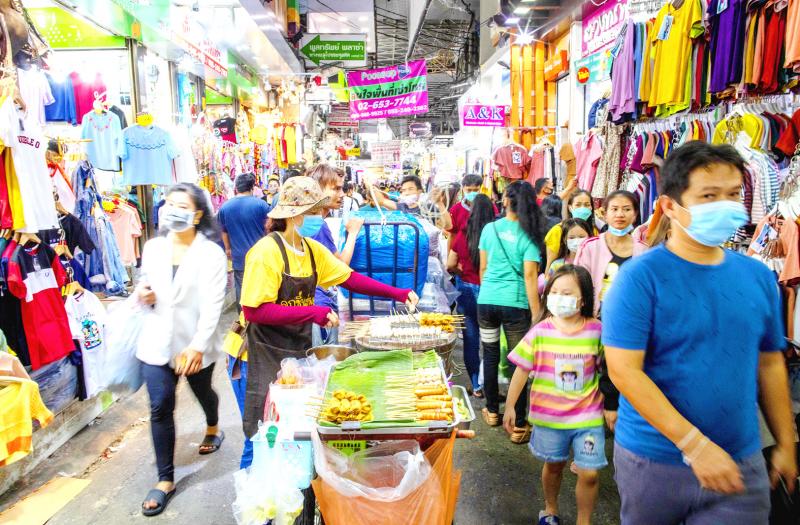Thailand’s economy saw its biggest annual contraction in 22 years and a record quarterly fall in the April-to-June period, as the COVID-19 pandemic and restriction measures hit tourism, exports and domestic activity, prompting an outlook downgrade.
Southeast Asia’s second-largest economy, which is heavily reliant on tourism and exports, shrank 12.2 percent in the second quarter from a year earlier, the worst contraction since the Asian financial crisis in 1998, data from the state planning agency showed.
That was better than a 13.3 percent slump seen in a Reuters poll, and compared with a downwardly revised 2 percent fall in the March quarter.

Photo: AP
On a quarterly basis, the economy shrank a seasonally adjusted 9.7 percent, the deepest on record, but better than the 11.4 percent drop forecast by economists.
The National Economic and Social Development Council cut its GDP forecast for this year. It now expects Thailand’s economy to shrink by 7.3 to 7.8 percent, having previously forecast a 5 to 6 percent contraction.
“Today’s economic release underscores the collapse of aggregate demand, both externally and internally,” Kasikornbank PCL capital markets research head Kobsidthi Silpachai said.
“Recovery will be lengthy as the shock to the demand and supply side has been the most severe in living memory,” he said.
While Thailand has lifted most lockdown restrictions after seeing no local transmission of COVID-19 for more than two months, its economy continues to suffer from an ongoing ban on incoming passenger flights and from tepid global demand.
The number of foreign visitors fell to zero in the April-to-June period, and Thailand has also shelved travel bubble plans amid new virus waves.
The planning agency expects only 6.7 million foreign tourists to come to Thailand this year, down 83 percent from last year’s record 39.8 million.
The downturn comes despite government efforts to support the economy with a 1.9 trillion baht (US$61 billion) fiscal stimulus package, while the central bank has also slashed interest rates by 75 basis points so far this year to a record low of 0.50 percent.
The impact of the lockdown and the travel ban is to continue to affect domestic consumption and investment, with anti-government protests adding to the risks, while exports would remain weak due to soft global demand, analysts say.
The state planning agency also cut its forecast for exports this year, expecting them to fall 10 percent versus a previous forecast for an 8 percent decline.

CHIP RACE: Three years of overbroad export controls drove foreign competitors to pursue their own AI chips, and ‘cost US taxpayers billions of dollars,’ Nvidia said China has figured out the US strategy for allowing it to buy Nvidia Corp’s H200s and is rejecting the artificial intelligence (AI) chip in favor of domestically developed semiconductors, White House AI adviser David Sacks said, citing news reports. US President Donald Trump on Monday said that he would allow shipments of Nvidia’s H200 chips to China, part of an administration effort backed by Sacks to challenge Chinese tech champions such as Huawei Technologies Co (華為) by bringing US competition to their home market. On Friday, Sacks signaled that he was uncertain about whether that approach would work. “They’re rejecting our chips,” Sacks

NATIONAL SECURITY: Intel’s testing of ACM tools despite US government control ‘highlights egregious gaps in US technology protection policies,’ a former official said Chipmaker Intel Corp has tested chipmaking tools this year from a toolmaker with deep roots in China and two overseas units that were targeted by US sanctions, according to two sources with direct knowledge of the matter. Intel, which fended off calls for its CEO’s resignation from US President Donald Trump in August over his alleged ties to China, got the tools from ACM Research Inc, a Fremont, California-based producer of chipmaking equipment. Two of ACM’s units, based in Shanghai and South Korea, were among a number of firms barred last year from receiving US technology over claims they have

BARRIERS: Gudeng’s chairman said it was unlikely that the US could replicate Taiwan’s science parks in Arizona, given its strict immigration policies and cultural differences Gudeng Precision Industrial Co (家登), which supplies wafer pods to the world’s major semiconductor firms, yesterday said it is in no rush to set up production in the US due to high costs. The company supplies its customers through a warehouse in Arizona jointly operated by TSS Holdings Ltd (德鑫控股), a joint holding of Gudeng and 17 Taiwanese firms in the semiconductor supply chain, including specialty plastic compounds producer Nytex Composites Co (耐特) and automated material handling system supplier Symtek Automation Asia Co (迅得). While the company has long been exploring the feasibility of setting up production in the US to address

OPTION: Uber said it could provide higher pay for batch trips, if incentives for batching is not removed entirely, as the latter would force it to pass on the costs to consumers Uber Technologies Inc yesterday warned that proposed restrictions on batching orders and minimum wages could prompt a NT$20 delivery fee increase in Taiwan, as lower efficiency would drive up costs. Uber CEO Dara Khosrowshahi made the remarks yesterday during his visit to Taiwan. He is on a multileg trip to the region, which includes stops in South Korea and Japan. His visit coincided the release last month of the Ministry of Labor’s draft bill on the delivery sector, which aims to safeguard delivery workers’ rights and improve their welfare. The ministry set the minimum pay for local food delivery drivers at